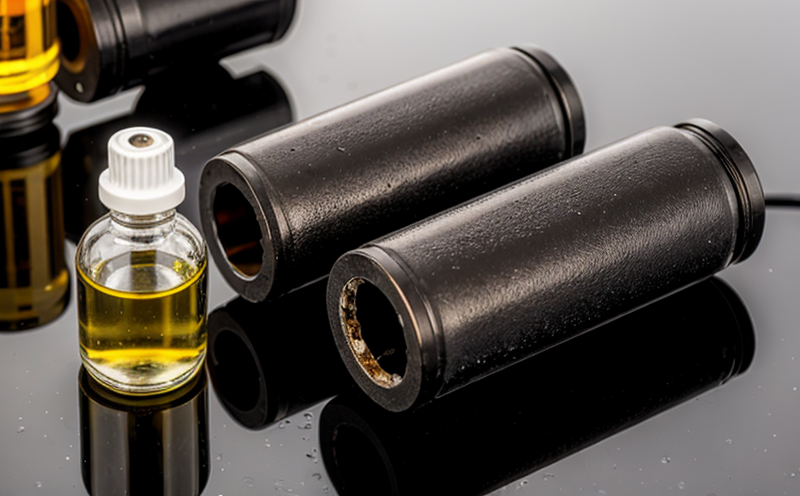ASTM D7679 Hydraulic Oil Hydrocarbons Test in Water
The ASTM D7679 test method is a critical process used to determine the concentration of hydrocarbons present in water samples, specifically targeting hydraulic oils. This test is particularly important for industries where machinery operates under harsh conditions and may release oil into the environment through leaks or malfunctions. The test helps ensure that compliance with environmental regulations is maintained while also protecting human health and ecosystems.
The ASTM D7679 method involves several steps, including sample collection, preparation, and analysis using a combination of filtration techniques followed by gravimetric determination of hydrocarbon content. This process ensures accurate measurement of oil in water samples, which can vary widely depending on the source of contamination. Understanding these variations is crucial for effective environmental monitoring and remediation efforts.
Hydraulic oils are widely used in various sectors such as manufacturing, construction, mining, and transportation due to their lubricating properties and ability to reduce friction between moving parts within machinery. However, improper disposal or accidental spills can lead to contamination of water sources, posing significant risks if not addressed promptly. By employing ASTM D7679 tests, organizations can monitor these potential hazards effectively.
The procedure outlined in ASTM D7679 involves multiple stages designed specifically for this purpose:
- Initial sampling: Collect representative samples from suspected contaminated areas using appropriate containers.
- Filtration: Filter the collected water sample through a pre-determined filter to retain only the oil particulates.
- Weighing: Accurately weigh both the total mass of the filtered solids and the original weight of the empty filter before filtration begins.
- Calculation: Calculate the hydrocarbon content based on the difference between final and initial weights of the filter.
This methodology provides reliable data essential for assessing environmental impact assessments (EIAs), pollution control measures, and compliance with relevant regulations like ISO 14001 or OSHA standards. For instance, in construction sites where heavy machinery operates continuously, regular ASTM D7679 testing ensures that any leaks are detected early enough to prevent broader ecological damage.
It is worth noting that while ASTM D7679 focuses primarily on hydraulic oils, it can also be applied more broadly to other types of hydrocarbon-based substances present in water. This adaptability makes the test valuable across numerous industries dealing with similar challenges related to oil contamination.
| Parameter | Description | Units |
|---|---|---|
| Total Hydrocarbon Content | Metric representation of all organic compounds in the sample. | mg/L or ppm |
| Filtration Efficiency | Percentage reduction achieved during filtration process. | % |
The accuracy and reliability of ASTM D7679 results depend heavily on proper sample handling practices and consistent laboratory procedures. Proper training for personnel involved in collecting samples and performing analyses is vital to ensure consistent outcomes across different sites or facilities.
Industry Applications
The ASTM D7679 test finds wide application in various sectors, including manufacturing, construction, mining, transportation, and waste management. Below are some specific instances where this testing method proves particularly useful:
- Manufacturing: Ensures compliance with local and international standards regarding discharge limits of hydrocarbons into water bodies.
- Construction: Helps monitor operations involving large equipment like excavators, cranes, and bulldozers that could potentially leak hydraulic fluids onto nearby ground or surface waters.
- Mining: Assists in tracking any unintentional discharges from mining rigs or vehicles used in exploration activities.
- Transportation: Supports fleet management by identifying sources of oil leaks within commercial fleets operating on roads or highways.
A table summarizing the key findings and comparisons between different environments where ASTM D7679 testing plays a crucial role is provided below:
| Environment | Main Contaminants | Potential Hazards | ASTM D7679 Role |
|---|---|---|---|
| Mining Site | Hydrocarbons from machinery, diesel fuel spills | Eutrophication, algal blooms, harm to aquatic life | Identify sources of contamination and set mitigation strategies |
| Construction Site | Lubricants from cranes, excavators, bulldozers | Pollution of local water tables, soil degradation | Detect early signs of pollution to prevent further spread |
In each case mentioned above, ASTM D7679 serves as an indispensable tool for identifying and managing hydrocarbon contamination risks effectively.
Eurolab Advantages
EuroLab offers unparalleled expertise in conducting ASTM D7679 tests with precision and accuracy. Our team of highly qualified professionals ensures consistent results, making our services invaluable to clients seeking reliable data for their environmental management plans.
- State-of-the-Art Facilities: Equipped with advanced analytical equipment capable of detecting even trace amounts of hydrocarbons in water samples.
- Experienced Staff: Our personnel are trained extensively on the latest techniques and methodologies related to ASTM D7679 compliance.
- Comprehensive Reporting: Providing detailed reports that include raw data, calculations, and interpretations tailored to meet specific client needs.
- Custom Solutions: Offering customized testing packages based on individual project requirements, whether it be for routine monitoring or specialized studies.
By leveraging these advantages, EuroLab consistently delivers high-quality service that meets or exceeds industry expectations. Whether you are a small business looking to comply with basic regulations or a large corporation aiming to lead in environmental stewardship, our expertise guarantees comprehensive support throughout the testing process.
Why Choose This Test
Selecting ASTM D7679 for your hydrocarbon analysis offers numerous benefits over other available methods. Here are some compelling reasons:
- Accurate Measurement: Ensures precise quantification of hydrocarbons, enabling accurate assessment of contamination levels.
- Regulatory Compliance: Helps businesses meet stringent environmental protection requirements set forth by governing bodies worldwide.
- Risk Mitigation: Early detection allows for proactive measures to be taken before significant damage occurs.
- Data Integrity: Provides consistent results across multiple samples, enhancing confidence in decision-making processes.
In conclusion, choosing ASTM D7679 means investing in robust environmental practices that contribute positively towards sustainability goals while safeguarding public health and safety.





